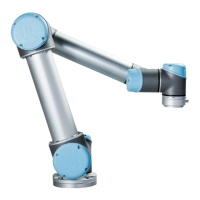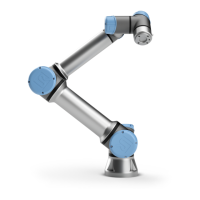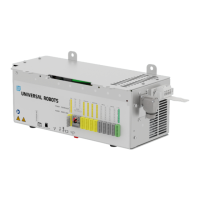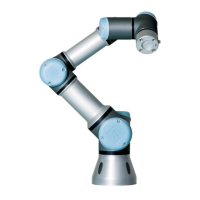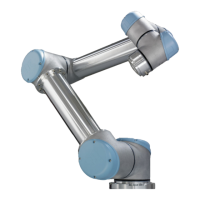13.9 Installation → Safety
1. Select the desired signal
2. Tap the text field in the lower part of the screen to set the name.
3. To reset the name to default, tap Clear.
A general purpose register must be given a user-defined name to make it available in the pro-
gram (i.e., for a Wait command or the conditional expression of an If command) The Wait and
If commands are described in (14.10) and (14.17), respectively. Named general purpose
registers can be found in the Input or Output selector on the Expression Editor screen.
13.8.3 I/O Actions and I/O Tab Control
Input and Output Actions: Physical and Fieldbus digital I/Os can be used to trigger actions or
react to the status of a program.
Available Input Actions:
• Start: starts or resumes the current program on a rising edge.
• Stop: Stops the current program on a rising edge.
• Pause: Pauses the current program on a rising edge.
• Freedrive: When the input is high, the robot is in freedrive ( similar to the freedrive
button). The input is ignored if a program is running or other conditions disallow
freedrive.
WARNING:
If the robot is stopped while using the Start input action, the robot
slowly moves to the first waypoint of the program before execut-
ing that program. If the robot is paused while using the Start input
action, the robot slowly moves to the position from where it was
paused before resuming that program.
Available Output Actions:
• Low when not running: Output is low when the program state is “stopped” or “paused”.
• High when not running: Output is high when the program state is “stopped” or
“paused”.
• High when running, low when stopped: Output is low when the program state is
“stopped” or “paused” and high when it is running.
• Continuous Pulse: Output alternates between high and low for a specified number of
seconds, while the program is running. Pause or stop the program to maintain the
pulse state.
I/O Tab Control: Specify whether an output is controlled on the I/O tab (by either programmers,
or both operators and programmers), or if it is controlled by the robot programs.
13.9 Installation → Safety
See chapter 10.
e-Series II-46 Version 3.11
Copyright © 2009–2019 by Universal Robots A/S. All rights reserved.

